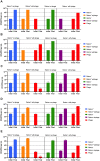The ecological consequences and evolution of retron-mediated suicide as a way to protect Escherichia coli from being killed by phage
- PMID: 37145987
- PMCID: PMC10162544
- DOI: 10.1371/journal.pone.0285274
The ecological consequences and evolution of retron-mediated suicide as a way to protect Escherichia coli from being killed by phage
Abstract
Retrons were described in 1984 as DNA sequences that code for a reverse transcriptase and a unique single-stranded DNA/RNA hybrid called multicopy single-stranded DNA (msDNA). It would not be until 2020 that a function was shown for retrons, when compelling evidence was presented that retrons activate an abortive infection pathway in response to bacteriophage (phage) infection. When infected with the virulent mutant of the phage lambda, λVIR, and to a lesser extent, other phages, a retron designated Ec48 is activated, the Escherichia coli bearing this retron element dies, and the infecting phage is lost. With the aid of a mathematical model, we explore the a priori conditions under which retrons will protect bacterial populations from predation by phage and the conditions under which retron-bearing bacteria will evolve in populations without this element. Using isogenic E. coli with and without Ec48 and λVIR, we estimated the parameters of our model and tested the hypotheses generated from our analysis of its properties. Our models and experiments demonstrate that cells expressing a retron-mediated abortive infection system can protect bacterial populations. Our results demonstrate that retron bearing bacteria only have a competitive advantage under a limited set of conditions.
Copyright: © 2023 Berryhill et al. This is an open access article distributed under the terms of the Creative Commons Attribution License, which permits unrestricted use, distribution, and reproduction in any medium, provided the original author and source are credited.
Conflict of interest statement
The authors have declared that no competing interests exist.
Figures




References
Publication types
MeSH terms
Substances
Grants and funding
LinkOut - more resources
Full Text Sources

